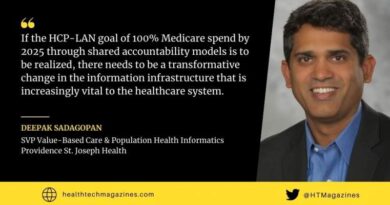Strategy aligned with risk & financial modeling to balance between FFS (Fee-For-Service) and VBC (Value-Based Care) agreements
By Jennifer a Houlihan, VP Value-Based Care & Population Health, Atrium Health Wake Forest Baptist
Health systems are pacing their investments and transition to value-based care as the need to balance the potential rewards from shared savings and risk contracts are required to make up for the difference in lost revenue by reduced utilization and investments in new care models.
With CMS’ latest white paper outlining its strategy for advancing value-based care that includes the expectation that all traditional Medicare beneficiaries receive care with a provider in the value-based care model by2030 and the fact that the Medicare population is projected to increase from 54 million beneficiaries today to over 80 million beneficiaries by 2030, the future is coming into focus. The view is that the future belongs to risk-based models and is forthcoming with a need for a more sustainable, fiscally responsible path to transition.
However, the present reality is that fee-for-service still dominates the health system’s financial performance and lowering the average length of stay, improving daily census and negotiating better fee-for-service contracts with payers drives margin performance in the short-term and where the majority focus often lies with health system leadership.
Overall, demonstrating financial solvency is critical to success and the need to maintain a margin of profitability prior to entering into value-based contracts as health systems navigate the transition from fee-for-service.
Ideally, strategy and buy-in is facilitated by a broad coalition of dedicated population health leaders and includes a strong executive sponsorship along with provider champions/leaders, managed care/contracting, finance, ambulatory operational and IT/analytics. With a high priority on generating revenues and profits via entrance into VBC arrangements, the need to develop an actionable glide path for risk that leads to a successful, margin-generating conversion is a key to defining infrastructure investments and modeling the impacts of new innovative models of care. The following synopsis outlines an approach to assessing the margin impact of value-based contracts.
Margin Analysis Overview
With a five-year history in taking progressive risk and an increasing number of primary care paneled patients (>40%) in ACO/shared risk contracts in Medicare and Medicare Advantage, our health system embarked on a contribution margin analysis to compare value-based patients and fee-for-service patients. Additionally, the analysis was part of an ongoing assessment to better understand the differentiation in contract structure and drivers of success that drive value margin.
The methodology included mapping registry data in the electronic medical record (EMR) to cost accounting data to match patients by their medical record number and encounter account activity. Further stratification included refining patients by primary care medical home engagement utilizing a minimum of one E&M professional claim in the previous two years and the exclusion of patients who did not have a primary care encounter in the same time period in order to mimic payer attribution logic. This was done to account for how population health infrastructure supports are directed to manage patient care gaps, utilization management, risk capture and pharmacy adherence/management.
Further steps included the comparison of reconciled value-based care payments to determine ACO and TIN-specific allocation for validating patient population and financial data to conduct a per-patient analysis to normalize and ensure consistency across the systems. Key findings found that margin gains were higher in contracts with the following attributes:
- Adequate # of lives in contract – preferable >10k to mitigate utilization impacts (especially seen during Covid inpatient admission impacts on utilization)
- Strong quality performance – preferable 4.5 Stars and above
- Quality multipliers rewarding 4+ STAR performance
- Adequate MLR supported by two years of claims history with a clear understanding of cost variables impacting medical trend
- Timely/accurate availability of data from payers to impact quality measures and utilization
- RAF score >1.3 with a key finding indicating that value surpasses FFS for higher complexity patients
- Inclusion of DSNP population with an appropriate care management focus
- Benefit and network design to ensure patients remain in a network such as an EPO structure
- History of partnership with payers along with success in P4P and/or SS prior to risk with 2-3+ years recommended to understand population, levers, and data
- Adequate and focused operations/investments dedicated to performance aligned with risk glide path supported by robust analytics
Continued focus for our system will be on assessing margin impacts of fee-for-service to value-based contract performance, focusing on smart growth in patient attribution in primary care, and assessing the value the ACO gains driven by population health management/performance. Additional considerations include accounting for a fee-for-service revenue resulting from population health interventions, including annual wellness visits, transitional care management and downstream revenue driven from proactive care gap closure (i.e., screenings, etc.).
Overall, demonstrating financial solvency is critical to success and the need to maintain a margin of profitability prior to entering into value-based contracts as health systems navigate the transition from fee-for-service. Payer partnerships and relationships will continue to be a focus along with other key factors for future analysis including: factoring in the increasing importance of patient equity, social drivers of health impact on risk and patient experience on new care models required to practice under value along with the impact of provider satisfaction and new compensation models.



